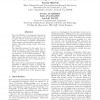301 search results - page 45 / 61 » Using Wikipedia for Automatic Word Sense Disambiguation |
COLING
2008
13 years 9 months ago
2008
We present an automatic method for senselabeling of text in an unsupervised manner. The method makes use of distributionally similar words to derive an automatically labeled train...
CIKM
2005
Springer
14 years 1 months ago
2005
Springer
In this paper, we propose a versatile disambiguation approach which can be used to make explicit the meaning of structure based information such as XML schemas, XML document struc...
TASLP
2010
13 years 2 months ago
2010
To solve the knowledge bottleneck problem, active learning has been widely used for its ability to automatically select the most informative unlabeled examples for human annotation...
ANLP
1992
13 years 9 months ago
1992
The real di culty in development of practical NLP systems comes from the fact that we do not have e ective means for gathering \knowledge". In this paper, we propose an algor...
LREC
2010
13 years 9 months ago
2010
Semantic lexicons and lexical ontologies are some major resources in natural language processing. Developing such resources are time consuming tasks for which some automatic metho...

